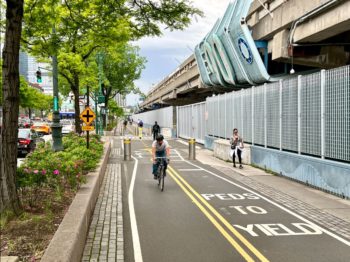
A portion of the Hudson River Greenway. Image Credit: NYC DOT.
The City Council’s Committee on Transportation and Infrastructure heard testimony regarding creation of a citywide Greenway Master Plan, the first such plan since 1993. On Wednesday, June 28th, the City Council’s Committee on Transportation and Infrastructure held a hearing on oversight and management of the city’s public space. The hearing included consideration of Int. 0291-2022, a bill which would require the Department of Transportation to partner with the Departments of Parks and Recreation, City Planning, Design and Construction, and Environmental Protection, as well as a private, non-profit development corporation, to create a citywide master plan for the construction and maintenance of greenways in all five boroughs. This is the first attempt to create such a plan since 1993.
The bill defines a greenway as a, “linear open space developed as right of way for recreational pedestrian use or non-motorized vehicle use.” The bill mandates the plan include a map of all existing and under-development greenways, with notations of and explanations for any closures, and an assessment of areas which could be developed into future sections of greenway or connected to existing greenways. The plan would be updated no less than quadrennially, while the map would be updated every quarter. In addition, Transportation would be responsible for a yearly report on the status of the plan’s implementation to be delivered to the Mayor and the City Council.
The bill’s lead sponsor is Council Member Carlina Rivera, whose district covers the East Village, Flatiron, Gramercy Park, Rose Hill, Kips Bay, Murray Hill, and the Lower East Side. She says it represents, “a vision for the future of greenways in all five boroughs.” She cited the disparity in investment on greenway infrastructure between wealthier and low-income, communities of color. “This bill seeks to disrupt that pattern and ensure that every neighborhood is involved in the development of a master plan.”
Representatives of the administration also cited the importance of equity in their testimony. Sarah Neilson, Chief of Policy and Long-Range Planning for the Department of Parks and Recreation, testified that, “New York City Parks firmly believes that all New Yorkers deserve access to quality public space, and we are committed to increasing equity in access. We see Greenways as an important step in achieving this.” New York City Department of Transportation commissioner Ydanis Rodriguez testified that, “Low- and moderate-income New Yorkers will especially benefit from a more comprehensive greenway network, as non-motorized transportation modes have lower costs to purchase, operate, and maintain.”
Many community organizations and individuals testified as to their support for the bill because of the benefits to cyclists, the over-65 population, and to communities with less access to green space, particularly the Bronx. Jon Orcutt of Bike New York, a cycling advocacy group which is part of the NYC Greenways Coalition, emphasized the importance of the bill’s transference of responsibility for the master plan from City Planning, a Department which does not traditionally build or maintain infrastructure, to the Departments of Transportation, Parks, Design and Construction, and Environmental Protection. He also cited a recent public opinion poll from the Regional Plan Association which found that, as he described them, “fully-protected, fully-separated, bike and pedestrian, multi-use paths, with green space,” were the most popular form of city streetscape development.
Robert Fanuzzi of the Bronx Council for Environmental Quality testified to the importance of equity in the development of greenways in the Bronx, warning about the influence of private developers. “We are seeing acres of waterfront turned into non-connected, non-greenway, open space,” aligning with zoning requirements from the Bloomberg administration. “It’s a huge loss for the Bronx side of the Harlem River.” He endorsed passage of the bill, “with the proviso that not only community boards be consulted but also community organizations, and that they play an active role in planning alongside city agencies.”
Other organizations represented at the hearings included Eastern Queens Greenway, New York Cycle Club, the Bronx River Alliance, Friends of Hutchinson River Greenway, the Harlem River Working Group, Transportation Alternatives, and the AARP.
The bill is currently laid over by committee. CityLand reached out to Council Member Rivera’s office and was told that, while no vote was currently scheduled, they anticipate that the bill will be voted on in the fall.
By: Christopher Kipiniak (Christopher is a CityLaw intern and a New York Law School student, Class of 2024.)
CC: Committee on Transportation and Infrastructure (Int. 0291-2022. 6/28/22).


Plan should remove lanes of highway to reduce automobile pollution and reject asphalt as surface because it is toxic and carcinogenic. Can’t have both autos and bicycles in same paradigm.